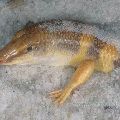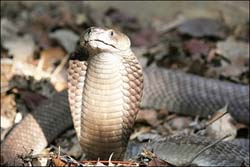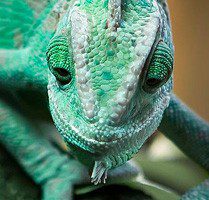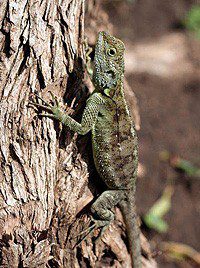
Tree agama
Already from the name of the tree agamas of the species Agama atricollis it is clear that nature, for sure, has adapted these lizards to an arboreal lifestyle. And above all, she gave them a patronizing coloration. Try to see the tree agama in the lush greenery of the tropical African forest – you are unlikely to succeed. Its variable brownish, olive or green body easily merges with foliage or tree bark, and its elongated shape can resemble anything – a protruding branch, an outgrowth on a trunk, or a piece of the same bark. The sharp claws of the tree agama help it deftly move through the trees. But there are also atypical representatives of Agama atricollis, for example, with a bright blue head. By the way, these lizards are excellent camouflage. Despite the incredulity and not the easiest taming, they like to keep tree agamas in terrariums. True, this is possible only if they are provided with suitable conditions – temperature, humidity, food. Tree agamas are rather capricious creatures and can easily wither away if something in the environment is not to their liking, that is, not for health. And do not expect devotion and affection from the lizard, it is not easy to make contact and at first it can be afraid of the owners, and after getting used to ignore it.
Contents
Classification
Kingdom: Animals
Type: Chord
Class: Reptiles
Order: Scaly
Suborder: Lizards
Family: Agamaceae
Genus: Agamas
Species: Tree agama Agama atricollis
Appearance
Of course, the tree agama is not a chameleon. But she also knows how to slightly change her color, adapting it to the surrounding conditions. Most often, the shades of the body of a lizard vary in the range of green – a little darker, a little lighter, more gray or silver-gray. However, the tree agama is not monotonous. Its skin has a varied pattern of irregularly shaped silver-green and yellowish spots, bluish and yellowish scales, and black spots on the shoulders, most noticeable on the lizard’s body. The head of the tree agama can also be of different colors – olive, bluish, gray or even emerald green, and the tail is most often green or gray with a silvery transverse stripe. In general, nature gave the tree agama all its most natural colors. And because of the uneven, rough skin with protruding scales, the resemblance of a lizard to woody vegetation is further enhanced.
Some species of tree agamas, like iguanas, have a spinal ridge, but it is barely noticeable. And sometimes just the scales along the spine of these lizards are slightly raised vertically. The teeth of the tree agama, like those of other members of the family, are located on the outer edge of the jaws and are called acrodont. Moreover, in adult agamas, there is a division of teeth into different types – fangs, incisors and molars. In fact, these teeth have only an external resemblance to the teeth of mammals, and therefore are called by analogy. Tree agamas do not change their teeth during their life, so they gradually wear down. The tongue of lizards is rather short.
Some reptiles have special pores on the inner thighs through which an odorous substance begins to be released during the breeding season, allowing individuals of different sexes to find each other and demonstrate readiness for mating. Tree agamas do not have such pores. The shape of the body of these lizards is also peculiar – slender and, as it were, slightly compressed from the sides, and the paws are quite long. So tree agamas are adapted to active tree climbing and are able to deftly bend around branches if the vegetation is especially dense. The fingers of lizards are also tenacious and rather long, there are five of them on each foot. And the tails of tree agamas are quite elongated, sometimes they can be equal to the length of the whole body with the head and even slightly exceed it, but, alas, they do not have the ability to bend upwards, but are mostly straight. The eyes of lizards are large, round and framed by movable eyelids, there is an open eardrum that can be seen. The triangular or heart-shaped head of the agamas is protected by especially dense polygonal scales and the same dense scales on the abdomen, especially in males. To the touch, the abdominal part of the body of a tree agama can sometimes resemble a corn, since the shields on it are covered with a dense translucent substance.
Distribution and habitation
 Tree agamas of the species Agama atricollis are heat-loving and moisture-loving creatures. Therefore, they feel best in the humid and evergreen tropical forests of East Africa. Among the countries of this continent where you can meet the agama, such states as Kenya, Tanzania, Uganda, Rwanda, Burundi, Mozambique, Ethiopia. There are a lot of valuable tree species in these forests, for example, ebony and copal, but in mountainous areas there are also coniferous forest areas overgrown with juniper with an admixture of broad-leaved trees. And of course, bamboo trees are typical for this region, however, they grow most often on the highest mountainous areas. It is in these forests that the tree agama lives. The lizard does not avoid dense wilds, where there is almost no undergrowth due to such dense vegetation that sunlight does not reach the lower tiers of forests, and it is always damp and cool below. And also the tree agama can be found in the jungle, where there is enough sun, and tall trees alternate with numerous shrubs and thickets of grapes.
Tree agamas of the species Agama atricollis are heat-loving and moisture-loving creatures. Therefore, they feel best in the humid and evergreen tropical forests of East Africa. Among the countries of this continent where you can meet the agama, such states as Kenya, Tanzania, Uganda, Rwanda, Burundi, Mozambique, Ethiopia. There are a lot of valuable tree species in these forests, for example, ebony and copal, but in mountainous areas there are also coniferous forest areas overgrown with juniper with an admixture of broad-leaved trees. And of course, bamboo trees are typical for this region, however, they grow most often on the highest mountainous areas. It is in these forests that the tree agama lives. The lizard does not avoid dense wilds, where there is almost no undergrowth due to such dense vegetation that sunlight does not reach the lower tiers of forests, and it is always damp and cool below. And also the tree agama can be found in the jungle, where there is enough sun, and tall trees alternate with numerous shrubs and thickets of grapes.
Behavior and lifestyle
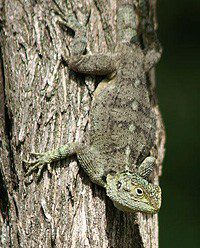 Of course, the name of the lizard – tree agama – speaks for itself. Where else to be this reptile, if not in the trees. But, despite the rather dense thickets of the tropical forest, the tree agama periodically chooses open areas – stumps, thick logs – to take sunbaths. This lizard is a very mobile creature, it moves nimbly and quickly along the trunks, but in case of danger it freezes and merges with the bark, which it is very similar to. And if a collision is still unavoidable, then the tree agama takes a defensive, intimidating pose, primarily to scare the enemy. She turns directly towards him, arches her neck, raises her head and opens her mouth wide to show her opponent the bright orange or yellow mouth inside. But this technique is required from the agama in exceptional cases, more often the “suit” of invisibility is enough. By the way, agamas with a bright blue head – a subspecies of tree agamas – have an even more effective appearance in this regard. Yes, and they themselves are slightly larger than a typical tree species of lizards. Agamas hunt in a very peculiar way, often taking a wait-and-see position and becoming invisible. But as soon as some insect crawls past them, it immediately finds itself in a trap from the lizard’s tongue, the tip of which is covered with mucous glands that hold the victim. In the same place where it comes to the leaves and fruits of plants, tree agamas wield their jaws.
Of course, the name of the lizard – tree agama – speaks for itself. Where else to be this reptile, if not in the trees. But, despite the rather dense thickets of the tropical forest, the tree agama periodically chooses open areas – stumps, thick logs – to take sunbaths. This lizard is a very mobile creature, it moves nimbly and quickly along the trunks, but in case of danger it freezes and merges with the bark, which it is very similar to. And if a collision is still unavoidable, then the tree agama takes a defensive, intimidating pose, primarily to scare the enemy. She turns directly towards him, arches her neck, raises her head and opens her mouth wide to show her opponent the bright orange or yellow mouth inside. But this technique is required from the agama in exceptional cases, more often the “suit” of invisibility is enough. By the way, agamas with a bright blue head – a subspecies of tree agamas – have an even more effective appearance in this regard. Yes, and they themselves are slightly larger than a typical tree species of lizards. Agamas hunt in a very peculiar way, often taking a wait-and-see position and becoming invisible. But as soon as some insect crawls past them, it immediately finds itself in a trap from the lizard’s tongue, the tip of which is covered with mucous glands that hold the victim. In the same place where it comes to the leaves and fruits of plants, tree agamas wield their jaws.
Food
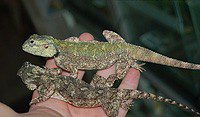 Tree agamas in the wild are unpretentious creatures. They can feed on available vegetation, diversifying it with various insects. These lizards rarely descend to the ground, only to lay eggs, the rest of the time they live and feed on trees. As for the nutrition of tree agamas in a terrarium, then here one should adhere to natural norms, that is, give them plant food and some animal food. Experts recommend crickets as the main animal food for lizards. It is also allowed to feed tree agamas with flour worms, some types of caterpillars and spiders, bedbugs, slugs and snails, best of all those that live on plants, since it is their lizards that are caught in the wild. Some tree dragons are accustomed to animal foods such as newborn rats or mice, and even chicken meat, but care should still be taken with these types of food. From plant food, agamas are recommended fruit and vegetable mixtures, as well as flowers, fruits and leaves of various plants, better than those that you can grow yourself, which means you will be sure that they are not poisonous. And of course, under artificial conditions, the vitamin balance in the body of the tree agama should be maintained with the help of special additives for reptiles.
Tree agamas in the wild are unpretentious creatures. They can feed on available vegetation, diversifying it with various insects. These lizards rarely descend to the ground, only to lay eggs, the rest of the time they live and feed on trees. As for the nutrition of tree agamas in a terrarium, then here one should adhere to natural norms, that is, give them plant food and some animal food. Experts recommend crickets as the main animal food for lizards. It is also allowed to feed tree agamas with flour worms, some types of caterpillars and spiders, bedbugs, slugs and snails, best of all those that live on plants, since it is their lizards that are caught in the wild. Some tree dragons are accustomed to animal foods such as newborn rats or mice, and even chicken meat, but care should still be taken with these types of food. From plant food, agamas are recommended fruit and vegetable mixtures, as well as flowers, fruits and leaves of various plants, better than those that you can grow yourself, which means you will be sure that they are not poisonous. And of course, under artificial conditions, the vitamin balance in the body of the tree agama should be maintained with the help of special additives for reptiles.
Reproduction
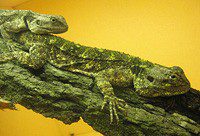 In the wild, tree dragons are more likely to become sexually mature than in captivity. But it is interesting that the males of these lizards generally mature later than the females. The average age for sexual maturity is one and a half years. In tropical latitudes, tree agamas usually breed during the rainy season, although the generally warm climate favors year-round breeding of lizards. In the mating behavior of the agamas, special courtship also takes place. When a male meets a female, she can either show a willingness to mate or refuse to mate. A supportive female arches her back and tail, raising her head.
In the wild, tree dragons are more likely to become sexually mature than in captivity. But it is interesting that the males of these lizards generally mature later than the females. The average age for sexual maturity is one and a half years. In tropical latitudes, tree agamas usually breed during the rainy season, although the generally warm climate favors year-round breeding of lizards. In the mating behavior of the agamas, special courtship also takes place. When a male meets a female, she can either show a willingness to mate or refuse to mate. A supportive female arches her back and tail, raising her head.
During mating, the male bites the female’s neck and places his paw on her back. The mating process itself takes only a couple of minutes, and some time after it, the female starts laying. It is the masonry that “motivates” the tree agama to descend from its heights, since it needs to bury the eggs in soft soil, after digging a suitable hole in it. The tree agama loosens the nest space with the help of its muzzle and paws, and then lays quite a lot (5-10 pieces) of small oval white speckled eggs there. Moist soil under the trees is especially suitable for this, but it is desirable that the place is sufficiently open, since solar heat is necessary for breeding young animals.
Interestingly, most agamas, including tree agamas, are thermoregulated reptile species. Moreover, in males, the body temperature is usually a couple of degrees higher (29) than in females (26-27). Tree agama babies are born quite small – 3-4 cm in size, but at the same time they have long tails, almost one and a half to two times longer than the body.
Content
Owners of these reptiles often ask herpetologists why dragons in captivity are so prone to skin diseases. The fact is that in an ordinary terrarium it is quite difficult to maintain a suitable temperature and humidity for them. But if you decide to start a tree agama, then be prepared for the constant and thorough care of your pet. First, provide him with the right amount of heat. An ordinary fluorescent lamp is also suitable for this, however, it should burn for at least 10 hours a day. The second important condition is the ventilation of the terrarium. Poor air access most often provokes diseases of lizards. For tree dragons, it is better to select a vertical terrarium and plant suitable plants in it so that the dragon can climb them. To maintain the desired level of moisture, you can install a special ventilation filter, but this is not enough. The tree agama, like some other lizards, needs to be bathed – at least once a week in warm water, and after bathing, in no case should it be brought into a cool room or a drafty place, but immediately lowered into a warm terrarium. And then your tree agama will live with you for a long time and will not cause unnecessary trouble.
Sources of
http://ours-nature.ru
http://www.floranimal.ru/
http://www.zoo-rm.ru/
http://www.zoopodolsk.ru



